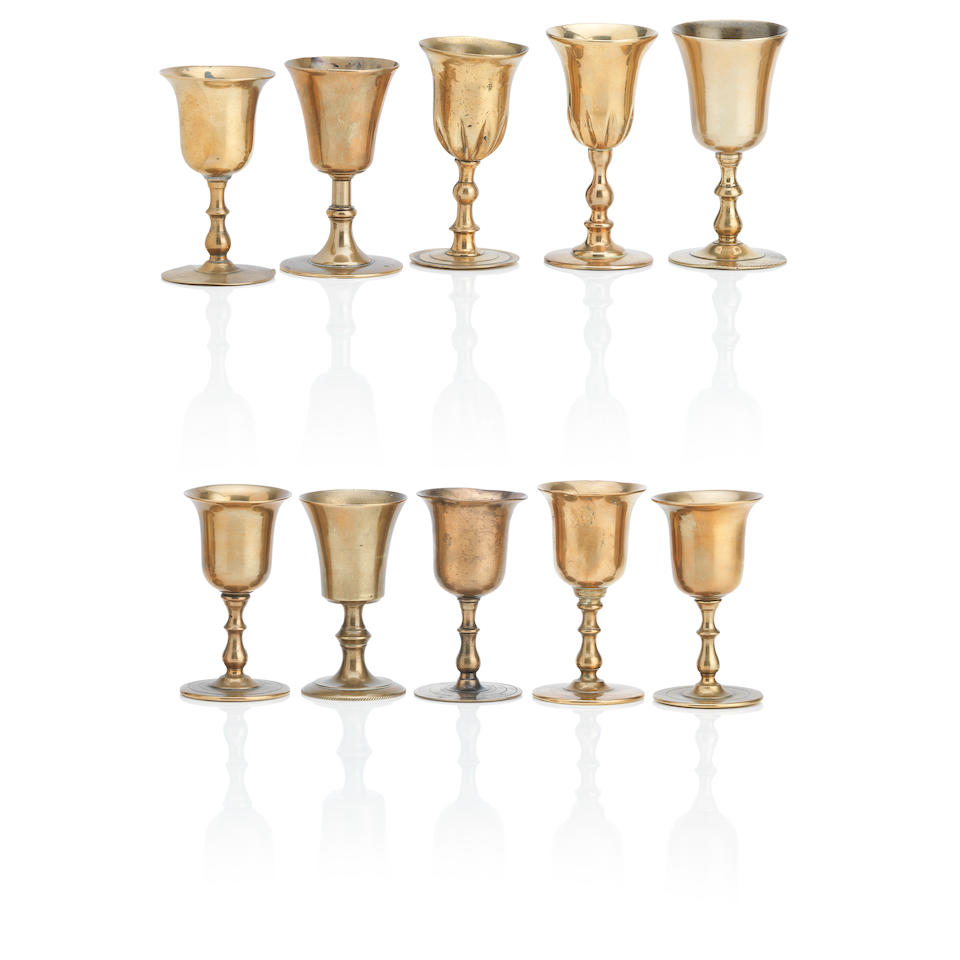60
Ten Scottish copper alloy travelling communion cups 18th/19th Century
Ten Scottish copper alloy travelling communion cups 18th/19th Century Most with bell shaped bowl, baluster stem and circular foot, maximum height 11cm. Footnotes: These small metal cups are thought to be exclusively Scottish, and this is the largest collection ever to be offered. They were the subject of an article published in the Journal of the Society of Friends of Dunblane Cathedral, Volume XI, 1970 and several of David McFarlan's cups were illustrated in this article which details the known facts about these intriguing cups. The known facts however are few. They are invariably small, but miniatures are occasionally found. They are formed in two parts, with the bowl and stem fixed by a threaded joint. Once taken apart, they can be reassembled, presumably for travelling with the stem and foot hidden inside the bowl. They were made singly and in pairs and there are almost endless minor variations within the few basic forms. Found in a variety of metals: bronze, brass and more rarely, white metal, there is no documentary record of their manufacture. It is presumed however that they were carried to church for the taking of communion wine. Very few are inscribed, and the earliest known dated example is inscribed 'Coldingham Abbey, 1700'. Many have bowls which are fluted in imitation of cut glass which seem to be inspired by early 19th century wine glasses and it would seem that the period of production spanned the period circa 1700-1830. For further information on this lot please visit Bonhams.com For further information about this lot please visit the lot listing
Ten Scottish copper alloy travelling communion cups 18th/19th Century Most with bell shaped bowl, baluster stem and circular foot, maximum height 11cm. Footnotes: These small metal cups are thought to be exclusively Scottish, and this is the largest collection ever to be offered. They were the subject of an article published in the Journal of the Society of Friends of Dunblane Cathedral, Volume XI, 1970 and several of David McFarlan's cups were illustrated in this article which details the known facts about these intriguing cups. The known facts however are few. They are invariably small, but miniatures are occasionally found. They are formed in two parts, with the bowl and stem fixed by a threaded joint. Once taken apart, they can be reassembled, presumably for travelling with the stem and foot hidden inside the bowl. They were made singly and in pairs and there are almost endless minor variations within the few basic forms. Found in a variety of metals: bronze, brass and more rarely, white metal, there is no documentary record of their manufacture. It is presumed however that they were carried to church for the taking of communion wine. Very few are inscribed, and the earliest known dated example is inscribed 'Coldingham Abbey, 1700'. Many have bowls which are fluted in imitation of cut glass which seem to be inspired by early 19th century wine glasses and it would seem that the period of production spanned the period circa 1700-1830. For further information on this lot please visit Bonhams.com For further information about this lot please visit the lot listing


